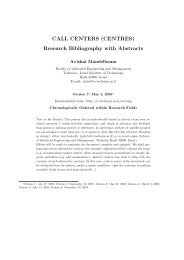Uncertainty in the Demand for Service - Faculty of Industrial ...
Uncertainty in the Demand for Service - Faculty of Industrial ...
Uncertainty in the Demand for Service - Faculty of Industrial ...
You also want an ePaper? Increase the reach of your titles
YUMPU automatically turns print PDFs into web optimized ePapers that Google loves.
4 Our Proposed Research<br />
In order to demonstrate how uncerta<strong>in</strong> arrival rate may <strong>in</strong>fluence staff<strong>in</strong>g decisions, we first<br />
consider an M/M/n+M queue with model-parameter uncerta<strong>in</strong>ty characterized by a random<br />
arrival rate Λ. We let <strong>the</strong> mean service time and <strong>the</strong> mean patience time be 1, i.e. µ = θ = 1,<br />
and we seek service level β which yields a time-stable delay probability α.<br />
Assume Λ is a discrete random variable with f<strong>in</strong>ite or countably <strong>in</strong>f<strong>in</strong>ite set <strong>of</strong> values KΛ, and a<br />
probability distribution pλi = P (Λ = λi). Let Ri = λi/µ denote <strong>the</strong> <strong>of</strong>fered load <strong>in</strong> case Λ = λi,<br />
and R <strong>the</strong> expected <strong>of</strong>fered load<br />
By <strong>the</strong> SLLN and <strong>the</strong> Garnett function (6):<br />
α = lim<br />
k→∞<br />
where,<br />
k<br />
j=1 Wj<br />
k<br />
j=1 Aj<br />
= lim<br />
k→∞<br />
1 k k j=1 Wj<br />
1 k k j=1 Aj<br />
R = <br />
pλi · Ri .<br />
KΛ<br />
= EW<br />
EA =<br />
<br />
KΛ pi · Ri · αi<br />
<br />
KΛ pi · Ri<br />
=<br />
<br />
KΛ pi · Ri · αi<br />
R<br />
Wj=Number <strong>of</strong> wait<strong>in</strong>g customers at day j;<br />
Aj=Number <strong>of</strong> arrivals at day j;<br />
<br />
N−Ri<br />
αi = P (W ait > 0|Λ = λi) = 1 − φ (s<strong>in</strong>ce µ = θ; o<strong>the</strong>rwise αi is <strong>the</strong> Garnett function<br />
(6)).<br />
√ Ri<br />
There<strong>for</strong>e, given α, we would like to f<strong>in</strong>d N. Then, assum<strong>in</strong>g a square-root staff<strong>in</strong>g rule, we<br />
calculate <strong>the</strong> QOS parameter β = N−R √ .<br />
R<br />
Because <strong>of</strong> <strong>the</strong> analytical tractability <strong>of</strong> <strong>the</strong> Erlang-A model, us<strong>in</strong>g R, one can calculate <strong>the</strong><br />
value <strong>of</strong> β <strong>for</strong> each α accord<strong>in</strong>g to (6). For analytically <strong>in</strong>tractable models, one can use <strong>the</strong> ISA<br />
simulation developed by [4] to obta<strong>in</strong> values <strong>of</strong> per<strong>for</strong>mance measures.<br />
13<br />
(8)
















